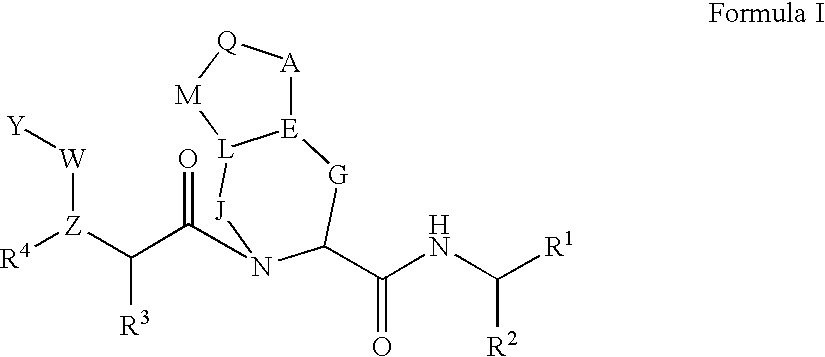Methods for treating hepatitis C
a technology for hepatitis c and treatment methods, applied in the field of treatment methods for hepatitis c, can solve the problems of poor treatment effect, low sustained response rate of therapies, frequent side effects, etc., and achieves less side effects, good efficacy, and sustained virological response
- Summary
- Abstract
- Description
- Claims
- Application Information
AI Technical Summary
Problems solved by technology
Method used
Image
Examples
example 2
Hypothetical Example 2
[0328] A double-blind, randomized study of patients afflicted with hepatitis C virus in which PEG-Intron 1.5 mcg / kg / week will be administered over a first time period and then a combination of the PEG-Intron with three dose levels of an HCV protease inhibitor plus optional weight based ribavirin (800 to 1400 mg / day). The study will compare treatment with PEG-Intron administered at 1.5 micrograms per kilogram SC once a week for 49 weeks throughout a first treatment period of about 24 to 168 hours in combination with PEG-Intron administered at 1.5 micrograms per kilogram SC once a week with various dosages of HCV protease inhibitor and optionally in combination with ribavirin, 1000 to 1200 mg per day PO for a total of 49 weeks.
First Period Administration
[0329] For all six treatment arms, PEG-Intron will be administered for one week as the first treatment period.
Second Period Administration
[0330] Subsequently, in the first treatment arm, PEG-Intron will be a...
example 1
Preparative Example 1
[0379]
Step A
[0380] A solution of pyrazinecarboxylic acid 1a (3 g) in 150 mL of dry dichloromethane and 150 mL of dry DMF was stirred at 0° C. and treated with HATU (1.4 eq, 6.03 g). L-cyclohexylglycine hydrochloride 1b (1.2 eq, 6.03 g) was added in small portions. Then, N-methylmorpholine (4 eq, 10 mL, d 0.920) was added dropwise. The reaction mixture was gradually warmed to room temperature and stirred for 20 h. All the volatiles were removed under vacuum and the residue was dissolved in 500 mL of ethyl acetate. The organic layer was washed with water (100 mL), aqueous 1N HCl (100 mL), aqueous saturated sodium bicarbonate solution (100 mL), and brine (100 mL). The organic layer was dried over magnesium sulfate, filtered and concentrated under reduced pressure. The residue was chromatographed on silica gel (gradient: acetone / hexanes; 5:95 to 3:7) to afford the product 1c as a white solid.
Step B
[0381] A solution of methyl ester 1c (6.5 g) in 270 mL of a 1:...
example a
Preparative Example A
[0396]
[0397] Step 1
[0398] A solution of acid 1 (255 mg) in 5 mL of dry dichloromethane and 5 mL of dry DMF was stirred at 0° C. and treated with HATU (368 mg). The amine hydrochloride 2 (201 mg) was added followed by addition of N-methylmorpholine (0.42 mL). The reaction mixture was gradually warmed to room temperature and stirred overnight. All the volatiles were removed under vacuum and the residue was taken into 100 mL of ethyl acetate. The organic layer was washed with aqueous 1N HCl (15 mL), aqueous saturated NaHCO3 (15 mL), water (15 mL), brine (15 mL), dried over MgSO4, filtered, and concentrated under reduced pressure to afford the desired product A1. No further purification was carried out for the product.
Step 2
[0399] A solution of A1 (360 mg) in 20 mL of a 1:1 mixture of toluene / DMSO was treated with EDCl (1.3 g) and dichloroacetic acid (0.42 mL, d 1.563). Reaction mixture was stirred at room temperature for about 3 h. The reaction mixture was dilu...
PUM
| Property | Measurement | Unit |
|---|---|---|
| time | aaaaa | aaaaa |
| weight | aaaaa | aaaaa |
| weight | aaaaa | aaaaa |
Abstract
Description
Claims
Application Information
 Login to View More
Login to View More - R&D
- Intellectual Property
- Life Sciences
- Materials
- Tech Scout
- Unparalleled Data Quality
- Higher Quality Content
- 60% Fewer Hallucinations
Browse by: Latest US Patents, China's latest patents, Technical Efficacy Thesaurus, Application Domain, Technology Topic, Popular Technical Reports.
© 2025 PatSnap. All rights reserved.Legal|Privacy policy|Modern Slavery Act Transparency Statement|Sitemap|About US| Contact US: help@patsnap.com



